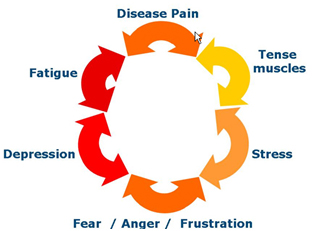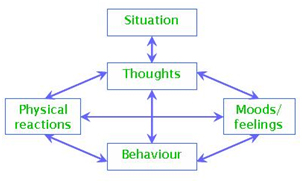By ADMIN on May 14, 2015
Cognitive Behavioral Therapy: Treating the mind as it relates to chronic pain
Ever wonder why some people experience chronic pain? Why some people seem to recover from an injury within weeks while others continue to experience symptoms months or even years after? Chronic pain is defined as any persistence of pain beyond three months duration. There are many factors, both physical and psychological, that affect whether a person will feel pain and how long that pain will last.
In the case of an acute injury, the intensity of pain typically correlates to the degree of damage/injury to the body. In 1965, Melzak and Wall described the Gait Control Theory of pain. According to this theory, once sensed by our peripheral nervous system, a noxious stimulus must pass through the spinal cord and up to the brain to be interpreted as “painful.”
Just like physical stimuli, thoughts and behaviours have the capacity to open/close the gait, thereby amplifying or dampening the pain. Cognitive behavioural therapy (CBT), begins with the premise that maladaptive beliefs and behaviours play an important role in the maintenance or exacerbation or mood, anxiety and somatic problems. People have beliefs, coping deficits and behavioural responses which make sense in situations involving acute pain but which become problematic in cases involving prolonged pain. An Athlete’s Care chiropractor trained in CBT principles can work with the patient to bring these thought patterns to the surface to determine whether the patients’ reactions to situations are accurate.

Through CBT, thoughts and beliefs are categorized into 3 levels : Automatic thoughts, intermediate beliefs and core beliefs. Automatic thoughts are at the surface (most easily accessible), are typically specific to a situation, and are most changeable. Core beliefs are deeply rooted views we have about ourselves and the world. They are general statements. These are least changeable and we are often not conscious of these core beliefs. Intermediate beliefs are the level in between.
Automatic thoughts - Intermediate beliefs - Core beliefs

Consider an example scenario: you are waiting to meet a friend for lunch in a restaurant and they are a half hour late
|
Interpretation |
1 |
2 |
3 |
|
Automatic thought |
They’ve been in an accident. |
They don’t want to have lunch with me. |
How rude. They always pull stuff like this. |
|
Intermediate belief |
They may be really hurt |
People don’t want to be my friend |
They are not respectful of my time |
|
Core belief |
People are susceptible to leaving/dying |
I am not loveable |
People will hurt me/disrespect me |
|
Bodily reaction/behaviour |
sweating, quickened heart beat, fidgeting, looking around, checking cell phone
|
hunched over, dejected and depressed
|
increased blood pressure, tension in upper traps, neck/back à muscle/joint pain
|
The above example highlights the various ways the mind and body can respond based on automatic thoughts that arise in a given situation. The resultant bodily reactions and behaviours can be quite different depending on the person’s internal thoughts and interpretation of the scenario.
As Athlete’s Care chiropractors, we are trained in functional integrated therapy, patient-centered care and holistic health. Often times with chronic pain, maladaptive thoughts and subsequent behaviours can keep a patient in the cycle of chronic pain, thereby preventing full recovery. By examining and challenging these thoughts using CBT principles, one can change the resulting behaviour, thereby affecting the sensation of pain.
Dr. Pamela MacDonald is a chiropractor currently seeing patients at Athlete's Care in the Beach and at the new clinic in Etobicoke/Kingsway.